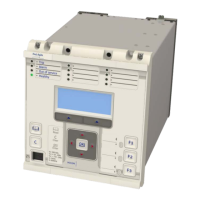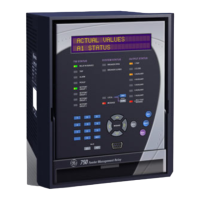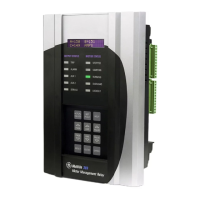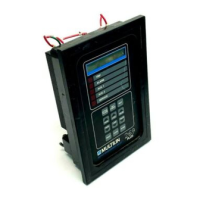IED RESPONSE
Fault type simulated
Forward fault in
zone 1
Forward fault at end of line
(within Z1X/Z2)
Reverse fault in zone 4
Permissive Scheme
(PUR/PUTT)
Trip, Signal Send Trip, Signal Send
Trip,
No Signal Send
No Trip, No Signal
Send
No Trip, No Signal
Send
No Trip, No Signal
Send
Permissive Scheme
(POR/POTT)
Trip, Signal Send Trip, Signal Send Trip, Signal Send
No Trip, Signal
Send
No Trip, No Signal
Send
No Trip, No Signal
Send
10.3.1 SCHEME TRIP TEST FOR ZONE 1 EXTENSION
1. Energise the Reset Z1X (Reset Zone 1 Extension) opto-input. This is done by applying a continuous DC
voltage onto the required opto-input, either from the test set, or station battery.
2. Inject an end of line fault. The duration of injection should be set to 100 ms. No trip should occur.
3. De-energise the Reset Z1X opto-input
4. Repeat the test injection and record the operating time. This should typically be less than 20 ms for 50 Hz,
and less than 16.7 ms for 60 Hz when set for instantaneous operation.
5. Switch OFF the AC supply and reset the alarms.
Note:
Here a non-zero tZ1 Ph or tZ1 Gnd time delay is set in the DISTANCE column, the expected operating time is typically within
+/- 5% of the tZ1 setting plus the “instantaneous” delay quoted above.
10.3.2
SCHEME TRIP TESTS FOR PERMISSIVE SCHEMES
This test applies to both Permissive Underreach, and Permissive Overreach aided scheme applications.
1. Energise the Signal Receive opto-input. This is done by applying a continuous DC voltage onto the required
opto-input from the test set, or station battery.
2. Inject an end of line fault, and record the operating time. The measured operating time should typically be
less than 20 ms for 50 Hz, and less than 16.7 ms for 60 Hz when set for instantaneous operation.
3. Switch OFF the AC supply and reset the alarms.
4. De-energise the Signal Receive opto-input (remove the temporary energisation link, to turn it OFF).
Note:
Where a non-zero Aided Distance Dly time delay is set in the DISTANCE menu column, the expected operating time is typically
within +/- 5% of the tZ1 setting plus the “instantaneous” delay quoted above.
10.3.3
SCHEME TRIP TESTS FOR BLOCKING SCHEME
1. Energise the Signal Receive opto-input. This is done by applying a continuous DC voltage onto the required
opto-input, either from the test set, or station battery.
2. Inject an end of line fault. The duration of injection should be set to 100 ms. No trip should occur.
3. De-energise the channel received opto-input.
4. Repeat the test injection, and record the operating time.
5. Switch OFF the AC supply and reset the alarms.
Note:
For blocking schemes, a non-zero Aided Distance Dly time delay is set, so the expected operating time is typically within +/-
5% of the delay setting plus the “instantaneous” operating delay. The trip time should thus be less than 20 ms for 50 Hz, and
less than 16.7 ms for 60 Hz, plus 1.05 x Delay setting.
P446SV Chapter 24 - Commissioning Instructions
P446SV-TM-EN-1 639












